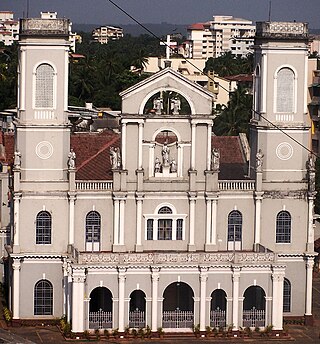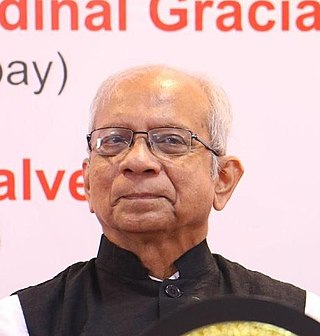Mangalorean Catholics are an ethno-religious community of Latin Christians from the Diocese of Mangalore and the erstwhile South Canara area, by the southwestern coast of present-day Karnataka, India.

The Milagres Church is a historic Roman Catholic Church situated in the Hampankatta locality of Mangalore. The church was built in 1680 by Bishop Thomas de Castro, a Theatine from Divar, Goa. The original structure was constructed at the site of the present-day cemetery. It is one of the oldest churches in Dakshina Kannada.

Cedric Prakash,, is a Catholic priest and a member of the Society of Jesus (Jesuits) of Gujarat in India. He is currently based in the city of Ahmedabad, Gujarat in Western India. He is well known for his work on human rights, reconciliation, and peace activism, with a focus on advocacy. He is also a prolific writer on subjects related to social justice, peace, communal harmony, environment, contextual spirituality, and the Constitution of India. His articles are regularly published in newspapers, magazines, and journals in India and abroad. He is also a visiting faculty in some colleges, universities, and seminaries in India, Europe, and the USA. Fr. Prakash speaks four languages - English, Gujarati, Hindi and French.

Father Jerome D'Souza, SJ was an Indian Jesuit priest, educationist, writer and member of the Indian Constituent assembly (1946–50).

The Church of Holy Cross of Hospet in Dakshina Kannada, is one of the ancient churches in the Mangalore Diocese of India. Being situated in Hosabettu, it is also known as Hospet Church. This was the only church that escaped the drive for the demolition of churches by Tipu Sultan during the Captivity of Mangalorean Catholics at Seringapatam.

The History of Mangalore dates back to the 3rd century BC and has been ruled by a number of rulers. In the era of modern India, the area was controlled by the Portuguese in Goa and Bombay, who lost it to Shivappa Nayaka, who in turn lost it to Hyder Ali.
The culture of Mangalorean Catholics has been shaped by their Christianisation in Goa, their migrations& their captivity. They adopted elements of the local Mangalorean culture, but retained many of their Konkani customs and values. The ethnic Mangalorean houses of the older generation have spacious porticos, red oxide cemented floors, terra cotta roofs layered with the once famous Mangalore tiles. The houses are usually accompanied by their own private wells or ponds, and are normally attached to orchards of coconut trees, jackfruit trees, ice apple trees, Alphonso mango trees, areca nut trees etc.
The History of Mangalorean Catholics comprises three major eras. The first era consists of the cultural heritage shaped by Indo-Aryan migration into the Indus valley, later the migration to Govapuri and other prominent areas of the Konkan region, possibly due to a natural disaster that caused the drying up of the Sarasvati. Also, the various invasions and the political upheavals that followed in the pre-Partition eras of the northwest Indian subcontinent might be responsible for migration to Konkan in Western India. The second era was the legacy of Lusitanian culture, from the conversion of their Konkani ancestors to Roman Catholicism in the colonies of the Portuguese in Goa and Bombay, and the final era being the migration of the Roman Catholics in Goa to Mangalore and other parts of South Canara between the mid-16th and mid-18th centuries, forming a unique Mangalorean Catholic identity, and the subsequent growth and development of the community. Four centuries of living in South Canara gave these Catholics an identity of their own, distinct from Goans and Bombay East Indians.

The Mangalorean Catholic Cuisine is the cuisine of the Mangalorean Catholic community.
Mangalorean Catholic names and surnames encompass the different naming conventions of the Mangalorean Catholic community. Historically, many of them had names of Christian saints, while Portuguese-language surnames were most commonly found. A formal Mangalorean Catholic name consists of a given name, a middle name, and a surname.
The captivity of Mangalorean Catholics at Seringapatam (1784–1799) was a 15-year imprisonment of Mangalorean Catholics and other Christians at Seringapatam, in the Carnataca region of India by Tippu Sultan, the de facto ruler of the Kingdom of Mysore. Estimates of the number of captives range from 30,000 to 80,000, but the generally accepted figure is 60,000, as stated by Tipu in the Sultan-ul-Tawarikh. The captivity was the most disconsolate period in the community's history.

Church of Our Lady of Rosary of Mangalore, or Rosario Cathedral is a Roman Catholic cathedral in the Roman Catholic Diocese of Mangalore, dedicated to Our Lady of the Rosary. It was the first Roman Catholic church in the Canara region. Historically, this was the only parish church in Mangalore reserved for the high-caste Mangalorean Catholics. It is the oldest church in Karnataka.

Monti Fest is a major Catholic festival held on 8 September every year by the Latin Catholic community of Konkani people, originating in the Konkan region of India, and their descendants in the Canara region of south India. This festival celebrates the Nativity of the Blessed Virgin Mary and in the Mangalorean Catholic community involves blessing of Novem. In certain Goan Catholic dialects the festival's name is corrupted to "Moti Fest".
Monte Mariano Church at Farangipet in Mangalore, India, is a church where the Roman Catholic festival Monti Fest was initiated by Joachim Miranda, a Goan Catholic priest at Farangipet in 1763.
Vincent John Peter Saldanha was an Indian Konkani language littérateur, dramatist, novelist, short-story writer and poet. He made significant contributions to Konkani literature as a poet, dramatist, novelist, and a litterateur.
Pius Fidelis Pinto is an Indian priest and research scholar of Christianity in Canara, India. He is noted for his research work and publications on the history of Konkani Christians of Dakshina Kannada then erstwhile South Canara. He has written eight books and presented 36 research papers at various events across the world.
Participation of Mangalorean Catholics in the Indian Independence Movement recounts the community's role in the Indian Independence Movement.

The Cathedral of Our Lady of Miracles, Indo-Portuguese; Catedral de Nossa Senhora dos Milagres, is a Roman Catholic Cathedral situated at Kallianpur in the Udupi district of Karnataka, India.

Aloysius Paul D'Souza is the former Bishop of the Roman Catholic Diocese of Mangalore. He was consecrated on 8 November 1996, succeeding his predecessor Basil Salvadore D'Souza.

St. Joseph Church, Belman is a Roman Catholic church and Parish is located in Belmannu, Karkala taluk, Udupi district, Karnataka, India. Formerly part of the Diocese of Mangalore, it became part of the Diocese of Udupi after Udupi became a separate diocese on 15 October 2011. The parish is part of the Archdiocese of Bangalore. It observes the Latin rite, with mass celebrated in Konkani with bilingual Kannada masses held on certain feast days.